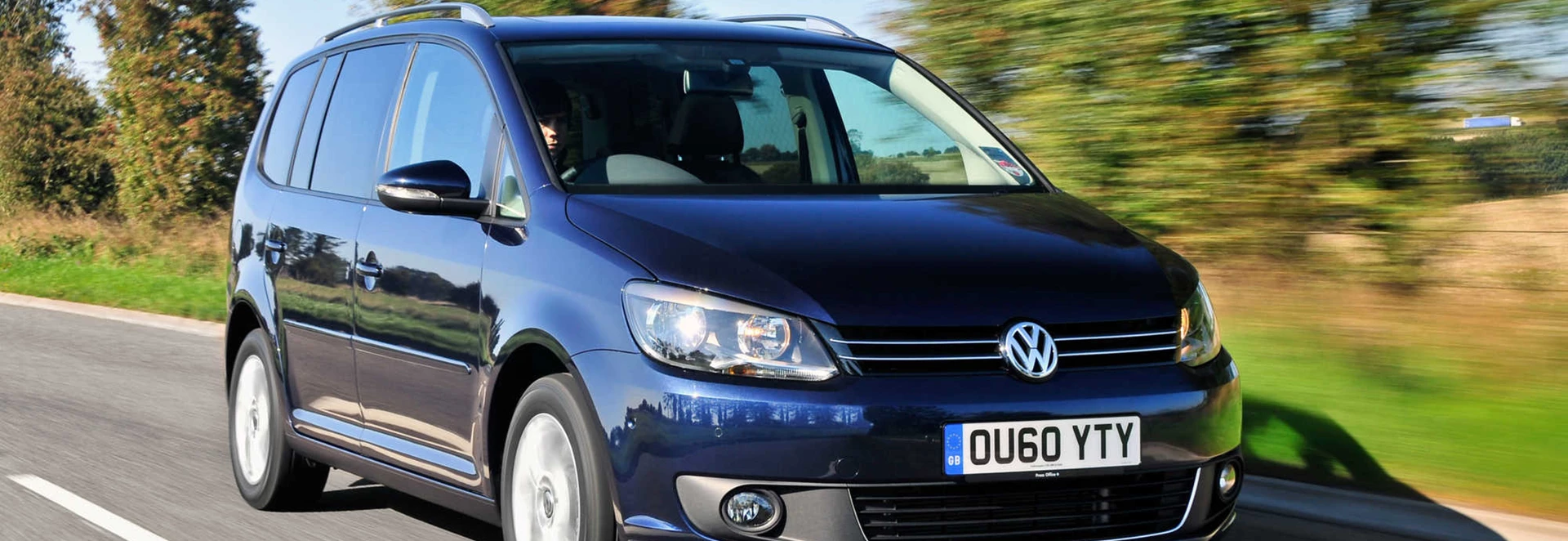The Touran is Volkswagen's seven-seat compact MPV, based on the previous-generation Golf rather than the current one with its MQB platform. It dates back to the early years of the century but was revised in 2009 with extra equipment and some styling revisions designed to make it resemble more modern VWs.
All versions are front-wheel drive, and most have TDI diesel engines, with power outputs ranging from 104bhp to 175bhp. Small turbocharged petrol options are also on offer, along with manual or VW’s coveted automatic.
Performance
Steady, now. The Touran is a car for transporting lots of people or inanimate objects from A to B in safety and comfort, not necessarily at great speed. If you do want performance, the 175bhp 2.0-litre TDI is the one for you, but with a 0-62mph time of 8.8 seconds it's no hot hatch.
1.4-litre TSI models and the 138bhp 2.0-litre TDI with manual transmission can beat 10 seconds for the 0-62mph run but none of the others can. The 1.6-litre TDI is the slowest of all at 12.8 seconds (no matter what gearbox it has). Does it matter? Not really. The important thing is that no Touran is painfully slow in the kind of driving it's most likely to be used for.
As usual, the diesels perform better at low engine speeds than the petrol models do, and of course they're more economical, but you would have to do a lot of miles before you overcame their price penalty. At the same time, that discrepancy will probably be balanced out at resale time if you keep the car for only two or three years.
Ride and Handling
Push on harder (like that's going to happen) and the front-end can start to become floaty on country roads.
The Touran is comfortable to drive and rides quite well at moderate speeds, with its rather supple suspension being a boon when it comes to cruising on long trips. Push on harder (like that's going to happen) and the front-end can start to become floaty on country roads. Few owners will contemplate doing this, but for those who might, there are other compact MPVs that feel more secure in these circumstances.
Interior and Equipment
The name Touran is a combination of the words 'tour' and 'Sharan', the latter being a much larger MPV also built by Volkswagen.
There are three trim levels called S, SE and Sport, none of them available with all the engines. The rule is that the more expensive the trim level, the higher the average power output in that part of the range. Park Assist, which allows the car to reverse into parallel or perpendicular parking spaces, is standard on the SE and Sport and an option on the S. Even the cheapest Touran comes as standard with roof rails, DAB digital radio, front and rear 12v sockets and pockets capable of holding bottles in each door. The SE has a third 12v socket, 16-inch wheels (the S runs on 15s), Bluetooth connectivity, privacy glass, Park Assist, a smattering of interior leather, extra storage spaces and four-way adjustable front headrests, while the Sport, available only with the 2.0-litre TDI engines, gets a styling upgrade, more front seat adjustability and cornering lights. The Touran's age is betrayed by the rather cheap nature of its interior, which has nothing like the quality of that of the current Golf. And, as with most seven-seat MPVs this size, the third-row seats are very much for small children only. If you need to carry seven adults, this is not the car for you. With all seats in place, luggage capacity is inevitably very limited at just 121 litres. Usefully, the seats in the extreme rear can be folded flat into the floor of the car, and if you fold down the middle ones as well (or remove them altogether, because that's possible too) the load volume increases to over 1,900 litres. Unlike more modern MPVs, the Touran has conventional slide doors rather than sliding ones at the rear.
Cost
Benefit In Kind taxation is rated at 20% now and will rise to 22% in April 2015.
The 1.6-litre TDI has the best fuel economy in the range - 61.4mpg on the official EU cycle but more likely 55mpg or so in everyday driving, or less if you spend most of your time in town. The 1.4-litre TSI is the least impressive at 41.5mpg, though this rises to 41.5mpg if you spend an extra £1,235 on the DSG gearbox. Since fuel consumption and CO2 emissions are very closely related it should come as no surprise that the 1.6-litre TDI's 121g/km figure is the best of any Touran. It makes the car cost £110 per year to tax, though rather annoyingly it would have been just £30 if Volkswagen had been able to achieve 120g/km. Benefit In Kind taxation is rated at 20% now and will rise to 22% in April 2015. The 177bhp 2.0-litre TDI and the 1.4-litre TSI will be the most expensive to tax, since their CO2 emissions are 150g/km and 154g/km respectively.
Our Verdict
A new Touran will surely be along soon, and we imagine Volkswagen will make a very good job of it. There's nothing particularly wrong with today's version, but it's overshadowed by other cars in the same class, and its unimpressive interior doesn't sit well with the fact that all but one version costs more than £20,000. Still, if all you're looking for is a practical vehicle with room for seven, and you're not worried about having the most modern car in the class, the Touran is a reasonable choice.




